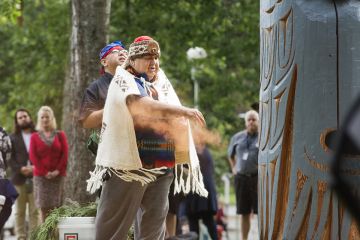S'YEWE Legend Pole rededicated
The S,YEWE Legend Pole (also known as the Elliott pole) in the UVic Quad was rededicated in a ceremony on Sept. 12, 2017 as part of this year's Indigenous Week of Welcome. The pole, by carver Charles Elliott of the Tsartlip First Nation, was raised in 1990 to mark the Learned Societies conference at UVic.
During the rededication and blessing ceremony, Elliott told the story he carved into the monumental pole.
In 2013 when rot was noticed around the base of the pole, it was examined by the artist, Royal BC Museum conservator George Field and Legacy Art Galleries’ Director Mary Jo Hughes. They discovered that when it was raised in 1990, it was not properly installed. The pole had been sitting directly on a concrete pad and when rain water pooled there, it was wicked up into the pole, resulting eventually in rot. It was caught soon enough and Facilities Management took down the pole and for several months, it dried out in a tent on the quad. A new base was constructed that lifted the pole above the ground.
Under the direction of Charles Elliott, artist John Livingston trimmed and restored the lower section of the pole. Livingston also repainted the pole with colours chosen by Elliott.
Indigenous works of art at UVic
UVic’s Legacy Art Galleries has worked with numerous local artists such as Charles Elliott over the years to create works of art in public spaces on campus that speak to the land upon which UVic sits and the traditions of the Indigenous peoples of the Pacific Northwest.
“Other works such as the two Tony Hunt poles in the quad and the Welcome Posts at the entrance of First Peoples House by Douglas LaFortune help to make the campus a vital cultural site,” said Mary Jo Hughes. “Legacy staff are stewards of these invaluable cultural markers that speak to the history and values of Indigenous peoples.”
UVic’s Legacy Art Gallery downtown has a very strong collection of Northwest coast art. In the last 18 months, Legacy has had a back-to-back schedule of Indigenous exhibitions including the current exhibition Origin Stories which honours the history of First Peoples of the Pacific Northwest. This exhibition includes a number of artists including one work by Charles Elliott and a video interview with the artist.
The S,YEWE legend
As told by Philip Pelkey; interpreted by Earl Claxton Sr.; written and edited by John Elliott and Linda Underwood
A long, long time ago, when our land was still heavy with forest, one young man, SWIWLES,S, became a new dancer. He was a very good dancer. He had a good style (S,IY,LE). His people were very proud of his dancing. When the moon of the Frog (WEXES) came along it was time to end the dancing season (PELKOE). The new dancers would then venture into the forest and take their uniforms off. They would put their hats on their canes and place them in the hollow of a cedar tree.
It was at this time the creator (XALS) appeared to SWIWLES,S and he told him that his style was very good; that through his bathing, venturing into the forest, and keeping a clean mind he would receive a gift for his goodness. The gift SWIWLES,S would receive would enable him to foretell the future. He would become a S,YEWE. The creator warned him never to tell anyone of the gift he received.
So, the young man returned home happy and excited about the gift he had received. When he and his wife went to bed that night he could no longer contain his excitement. He thought to himself, that if he whispered in his wife's ear, no one would hear. The moment he whispered into his wife's ear, he realized that he had wronged the Creator.
The very next morning, SWIWLES,S and his wife packed their things and put them in their canoe. They paddled towards Cordova Bay and when they arrived the creator spoke to them from amongst the Blue Herons at Point Roberts. The young man told his wife not to listen. He said, "Get off the canoe and we will go up into the forest and hide." Since they did not stop, the Creator became angry. He cast a Quentoles (stone) at them. Just as SWIWLES,S was pushing his wife up the hill the round black rock struck them and they turned into stone. Today at Cordova Bay, one can still see the pair pushing each other up the hill with the stone lodged in the man.
In this story
Keywords: Elliott pole, Elders, Indigenous, student life, community
People: Charles Elliott, John Livingston

